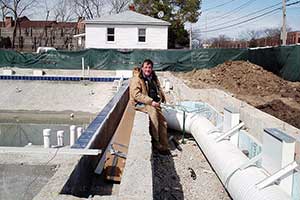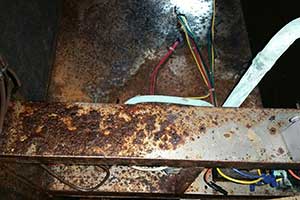“It’s Just Another Room”
Quite often, pool room dehumidification systems are an “afterthought”. Structures are completed without consideration for controlling humidity, ductwork systems, vapor barrier, negative pressure, and mechanical space to name a few. The cost of preventing problems in the design stage is much less than the repair costs down the road.
“We Don’t Need a Dehumidifier; We’ll Just Install Some Exhaust Fans”
Fresh Air and Air-To-Air Heat Exchanger Systems Cannot Work Under All Conditions.
As far back as the late 1980’s and early 1990’s, many clients were convinced that waste ventilation (meaning large exhaust fans and make up air) could be used to control indoor pool high humidity. Some still do today. A ventilation system can only provide effective humidity control for an indoor pool when the outdoor air is reasonably dryer or the same as the indoor air with a lower relative humidity 365 days per year. These conditions rarely exist and pool heat is literally being thrown out the window (hence “waste ventilation” gets its name). Although upfront costs may be less, it soon becomes apparent that operating costs of these old ventilation systems are also the highest when compared to a properly designed dehumidification system.
Under-Sizing the Dehumidification System for the Indoor Pool Room
Sizing a system to dehumidify a pool room has two major components to consider. First is the compressor section to meet the evaporation rate based on pool and spa size, water temperatures and activity factors within the pool room. The second and most often ignored is the air turnover rate, (i.e., air handling component based on the cubic feet of space). Many companies size for evaporation but neglect to accurately determine and consider the VOLUME of the room. Inadequate air movement in natatoriums is disastrous due to humid natural air stratification that can cause rapid deterioration of the upper structure components of the pool enclosure.
“We’ll Put In Ductwork Just Like We Did With Our House”
We equate ductwork in a pool room to the “arteries”, with the dehumidification system being the “heart”. Good heart, bad arteries will always result in an unhealthy building with a poor life expectancy. Ductwork design is NOT the same for an indoor pool as it is in a residence or commercial building. In our decades of consulting, close to 90% of all ductwork in indoor swimming pools is inadequate, ill designed, undersized and misapplied. This has become DXair’s number one priority for all of our clients in new construction and in existing pool rooms.
“We’ll Heat the Room With the Swimming Pool”
There are a plethora of companies that design and build swimming pool enclosures who tell clients that they do not need a dehumidification system and the heat from the pool will heat the room. There is nothing further from the truth. Heating up an indoor pool outside of the normal range of temperatures creates increased evaporation/humidity levels when water is warmer than air; dehumidification may not be sized to handle the increased loads; and this potentially leads to higher operating costs, building damage, rust, corrosion, mold and mildew within the structure. Much like your home or office, you must also heat the space with a secondary heat source. This is always included with the DXair package based on your heating sources available.
Believing Expensive Building Materials Will Make Your Building Bullet Proof
Many design build companies and architects recommend using expensive building materials to negate the effects of high humidity. This is futile and a waste of money simply because if there is excess humidity mixed with chlorine, it is only a matter of time before all types of so called “water proof” materials and metals fail. Therefore, if a properly designed environmental control system is installed, an enclosure can be built out of standard/conventional building materials and expect the same life expectancy as any other type building.
Pool Room Dehumidifiers Using 8-Row Evaporator Coils
The evaporator coil in any dehumidifier is the component that takes the moisture out of the air. Early manufacturers designed equipment with 8 row coils and still use them today. Two important facts about 8 row coils: one, they do not remove more moisture than a 4 row coil, and two, 8 row coils are impossible to clean. Dehumidifiers that are manufactured with 3, 4 or 5 row evaporator coils have a longer life span; less maintenance and less operating/replacement costs. DXair dehumidifiers use 35% less fan horsepower to pull the air through a 4 row evaporator coil making our design cleanable, less maintenance and much more energy efficient. (For more on this subject, please see the engineering study titled “Coil Myths” in the Articles section of our website.)
Inadequate Mechanical Space Is Definitely Going To Cost You Money
This has been a problem in this industry for a long time. Equipment that has been crammed into closets, crawl spaces, and attic spaces and causes problems for the mechanical firm in the installation process, air flow/ductwork transitions, and further down the road for the client for service/preventive maintenance of the dehumidification system. In some cases we find equipment installed hanging in the pool room! One of the fastest ways to shorten the lifespan of dehumidification systems is to install it over an indoor pool or in the same room as a chemically treated body of water, where, chlorine and humidity can “attack” it on a daily basis. We generally make the comparison of taking a Lexus, opening the hood and leaving it parked on an oceanfront beach for the next 10 years. Would you do that? Of course not!
Installing Drop Ceilings In an Indoor Pool Room
Humidity is nature’s water pump. A suspended ceiling in any swimming pool area is asking for trouble. Moisture can migrate into the dead air space above the ceiling and proceed to deteriorate the structure area above. It can also migrate to other areas of the building. Therefore, any potential dead air space areas must be considered part of the overall environment and must be conditioned to remove the humidity and avoid any potential building damage. When a drop ceiling is in place, it is recommended to ventilate with pool room air, ensure it is insulated above it, ensure that a vapor barrier has been installed on the warm side of the pool room and address negative pressure. Drop ceilings can be ventilated; however; there are really no guarantees when drop ceilings are utilized. DXair recommends that drop ceilings be avoided when feasible to do so.
Avoid These Mistakes and More
Our Design Guideline Bulletins contain a wealth of information to help you achieve effective humidity control in your pool room or enclosure. Get those Design Guideline Bulletins here…
DXair is an expert in the natatorium industry. Our DXair Pool Room Dehumidifiers are designed exclusively for use in indoor swimming pool applications: From lap pools to schools, rehab centers, fitness facilities, to large hotel/resort indoor natatoriums and water parks. Anywhere humidity needs to be controlled, DXair provides a perfect balance of solutions for building and equipment with the DXair System—365 days a year.

With no dehumidification system and believing they could rely on exhaust fans to control humidity, this health club was forced to shut down due to structural deterioration and severe mold and mildew growth

Proper ductwork for a pool room isn’t like any other room, it’s usually needed below ground, at ground level, and at the ceiling

There are so called “experts” out there who will tell you you don’t need dehumidification equipment or you can use the pool to heat the pool room; we strongly recommend you not listen to them

8 row evaporator coils are good for the seller to make more profit but bad for the buyer

Providing adequate mechanical space is a huge advantage for routine equipment maintenance and having it inside instead of on the roof is even better (technicians are human and better able to perform intricate work indoors)
